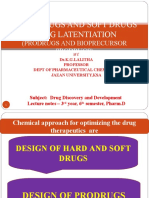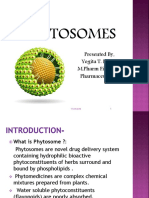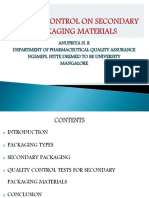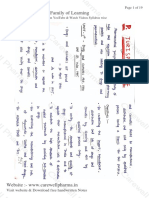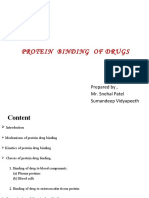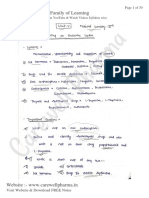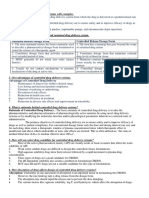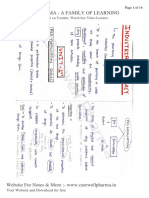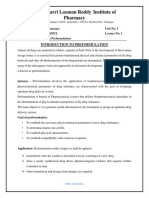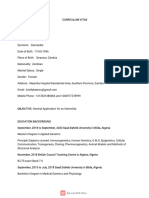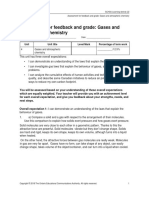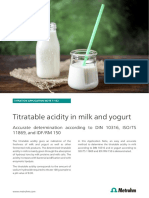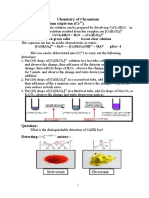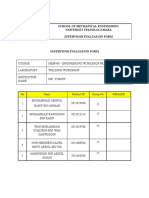Microencapsulation
Introduction:
Microencapsulation is defined as a process of enclosing or enveloping solids, liquids or
even gases within second material with a continuous coating of polymeric materials
yielding microscopic particles (ranging from less than 1 micron to several hundred
microns in size). In this process, small discrete solid particles or small liquid droplets
and dispersions are surrounded and enclosed by applying thin coating for the purposes
of providing environmental protection and controlling the release characteristics or
availability of coated active ingredients. Microencapsulation process is widely
employed to modify and delayed drug release form different pharmaceutical dosage
forms. The materials enclosed or enveloped within the microcapsules are known as core
materials or pay-load materials or nucleus, and the enclosing materials are known as
coating materials or wall material or shell or membrane.
Microparticles:
“Microparticles” refers to the particles having the diameter range of 1-1000
μm,irrespective of the precise exterior and/or interior structures.
Microspheres:
“Microspheres” particularly refers to the spherically shaped microparticles
within thebroad category of microparticles.
Microcapsules:
“Microcapsules” refers to microparticles having a core surrounded by the coat or
wall material(s) distinctly different from that of the core or pay-load or nucleus, which
may be solid, liquid, or even gas.
Microcapsules can be classified on three types
(Fig. 1):i). Mononuclear: Containing the shell
around the core.
ii). Polynuclear: Having many cores enclosed with in shell.
iii). Matrix type: Distributed homogeneously into the shell material.
1
� Fig. 1: Classification of microcapsules
Advantages of microencapsulation:
i). Providing environmental protection to the encapsulated active agents or core
materials.ii). Liquids and gases can be changed into solid particles in the form of
microcapsules.
iii). Surface as well as colloidal characteristics of various active agents can be
changed. iv). modify and delayed drug release form different pharmaceutical
dosage forms
v). Formulation of sustained controlled release dosage forms can be done by
modifying ordelaying release of encapsulated active agents or core materials.
Disadvantages of microencapsulation:
i). Expensive techniques.
ii). This causes reduction in shelf-life of hygroscopic agents.
iii). Microencapsulation coating may not be uniform and this can influence the release
ofencapsulated materials.
Methods of microencapsulation:
(a) Air suspension:
Microencapsulation by air suspension method consists of the dispersing of solids,
particulate core materials in a supporting air stream and the spray coating on the air
suspended particles (Fig. 2). Within the coating chamber, particulate core materials are
suspended on an upward moving air stream. The chamber design and its operating
2
�parameters influence a re- circulating flow of the particles through the coating-zone
portion of the coating-chamber, where a coating material is sprayed to the moving
particles. During each pass through the coating-zone, the core material receives a coat
and this cyclic process is repeated depending on the purpose of microencapsulation. The
supporting air stream also serves to dry the product while it is being encapsulated. The
drying rate is directly related to the temperature of the supporting air stream used.
Fig. 2: Air suspension method for microencapsulation
(b) Coacervation phase separation:
Microencapsulation by coacervation phase separation method consists of 3 steps:
1. Formation of 3 immiscible phases: a liquid manufacturing phase, a core material
phase, and a coating material phase.
2. Deposition of the liquid polymer coating on the core material.
3. Rigidizing the coating usually by thermal, cross linking or desolvation techniques
to form microcapsules.
The deposition of liquid polymer coating around the interface formed between the core
material and the liquid vehicle phase (Fig. 3). In many cases, physical or chemical
changes in the coating polymer solutions can be induced so that phase separation of the
polymers will occur. Droplets of concentrated polymer solutions will form and coalesce
to yield a two-phase liquid- liquid system. When the coating material is an immiscible
polymer, it may be added directly. Also, monomers can be dissolved in the liquid vehicle
phase and subsequently polymerized at interface. Important equipment’s necessary for
3
�microencapsulation by coacervation phase separation method are jacketed tanks with
variable speed agitators.
Fig. 3: Coacervation phase separation method for microencapsulation
(c) Pan coating:
For relatively large particles, which are greater than 600 µ in size,
microencapsulation can be done by pan coating method, which is being widely used in
pharmaceutical industry for the preparation of controlled release particulates. In this
method, various spherical core materials, such as nonpareil sugar seeds are coated with
a variety of polymers (Fig. 4). In practice, the coating is applied as a solution or as an
atomized spray to the desired solid core material in the coating pan. Generally, warm air
is passed over the coated materials as the coatings are being applied in the coating pans
to remove the coating solvent. In some cases, the process of final solvent removal is
accomplished in the drying oven.
Fig. 4: Pan coating method for microencapsulation
4
�(d) Fluidized-bed technology
Fluidized-bed technology method for microencapsulation is used for the
encapsulation of solid core materials, including liquids absorbed into porous solids. This
microencapsulation method is expansively employed to encapsulate pharmaceuticals.
Solid particles to be encapsulated are suspended on a jet of air and afterward, are covered
by a spray of liquid coating material. The capsules are traveled to an area where their
shells are solidified by cooling or solvent vaporization. The processes of suspending,
spraying, and cooling are repeated until the attainment of the desired thickness of the
capsule-wall. This is known as Wurster process when the spray nozzle is located at the
bottom of the fluidized-bed of particles.
(e) Spray drying and spray congealing:
Spray drying and spray congealing methods of microencapsulation are almost
similar in that both the methods entail the dispersion of core material in a liquefied
coating agent and spraying or introducing the core coating mixture into some
environmental condition, whereby relatively rapid solidification of the coating is
influenced (Fig. 5). The main difference in- between these two microencapsulation
methods are the means by which the coating solidification is carried out. In spray drying
method, the coating solidification is influenced by the quick evaporation of a solvent, in
which the coating material is dissolved. In spray congealing method, the coating
solidification is accomplished by the thermal congealing of molten coating material or
solidifying a dissolved coating by introducing the coating core material mixture into a
non- solvent. Removal of non-solvent or solvent from the coated product is often done
by sorption extraction or evaporation.
5
� Fig. 5: Spray drying method for microencapsulation
(f) Multiorific-centrifugation
Multiorific-centrifugation method for microencapsulation utilizes the centrifugal
forces to hurl a core particle trough an enveloping membrane. Various processing
variables of multiorific- centrifugation method include (i) rotational speed of the
cylinder, (ii) flow rate of the core and coating materials, and (iii) concentration, viscosity
and surface tension of the core material. The multiorifice-centrifugal method is capable
for microencapsulating liquids and solids of varied size ranges with diverse coating
materials. The encapsulated product can be supplied as slurry in the hardening media or
as dry powder.
(g) Solvent Evaporation
Solvent evaporation method is appropriate for liquid manufacturing vehicle
(O/W emulsion), which is prepared by agitation of two immiscible liquids. The solvent
evaporation method involves dissolving microcapsule coating (polymer) in a volatile
solvent, which is immiscible with the liquid manufacturing vehicle phase. A core
material (drug) to be microencapsulated is dissolved or dispersed in the coating polymer
solution. With agitation, the core–coating material mixture is dispersed in the liquid
manufacturing vehicle phase to obtain the appropriate sized microcapsules. Agitation of
system is continued until the solvent partitions into the aqueous phase and is removed
by evaporation. This process results in hardened microcapsules. Several techniques can
be used to achieve dispersion of the oil phase in the continuous phase. The most common
6
�method is the use of a propeller style blade attached to a variable speed motor. Various
process variables namely rate of solvent evaporation for the coating polymer(s),
temperature cycles and agitation rates influence the methods of forming dispersions. The
most important factors that should be considered for the preparation of microcapsules
by solvent evaporation method include choice of vehicle phase and solvent for the
polymer coating, and solvent recovery systems. The solvent evaporation method for
microencapsulation is applicable to a wide variety of liquid and solid core materials. The
core materials may be either water soluble or water insoluble materials. A variety of film
forming polymers can be used as coatings.
(h) Polymerization:
The polymerization method of microencapsulation is used to from protective
microcapsule coatings, in situ. The method involve the reaction of monomeric units
positioned atthe interface existing in-between a core material and a continuous phase,
wherein the core material is dispersed. The continuous or core material supporting phase
is usually a liquid or gas, and therefore, the polymerization reaction occurs at the
interfaces of liquid-liquid, liquid-gas, solid-liquid, or solid-gas.
(i) Interfacial cross-linking
In interfacial cross-linking method of microencapsulation, the small bifunctional
monomer containing active hydrogen atoms is replaced by a biosourced polymer, like a
protein. When the reaction is performed at the interface of an emulsion, the acid chloride
reacts with the various functional groups of the protein, leading to the formation of a
membrane. The interfacial cross-linking method of microencapsulation is very versatile
for pharmaceutical or cosmetic applications.
Applications:
1. Microencapsulation can be used to formulate various sustained controlled release
dosage forms by modifying or delaying release of encapsulated active agents or
core materials.
2. Microencapsulation can also be employed to formulate enteric-coated dosage
forms, so that the drugs will be selectively absorbed in the intestine rather than
the stomach.
7
�3. Gastric irritant drugs are being microencapsulated to reduce the chances of
gastricirritation.
4. The taste of bitter drug candidates can be masked by employing
microencapsulationtechniques.
5. Through microencapsulation, liquids and gases can be changed into solid
particles in the form of microcapsules.
6. Microencapsulation can employ to aid in the addition of oily medicines to
tableted dosage forms to overcome the problems of tacky granulations and in
direct compression.
7. Microencapsulation can be used to decrease the volatility. A microencapsulated
volatile substance can be stored for longer times without any substantial
evaporation.
8. Microencapsulation provides environmental protection to the encapsulated active
agents from various environmental issues, such as light, heat, humidity,
oxidation, etc.
9. The hygroscopic characteristics of many core materials can be reduced by
microencapsulation.
10. The separations of incompatible substances can be achieved by
microencapsulation. For example, pharmaceutical eutectics can be separated by
microencapsulation. This is a casewhere direct contact of materials brings about
liquid formation. The stability enhancement of incompatible aspirin-
chlorpheniramine maleate mixture is accomplished by microencapsulating both
before mixing.
11. Microencapsulation is used to lessen the potential danger of toxic substance
handling. The toxicity owing to handling of herbicides, insecticides, pesticides
and fumigants, etc., can be usefully lessened after microencapsulation.








